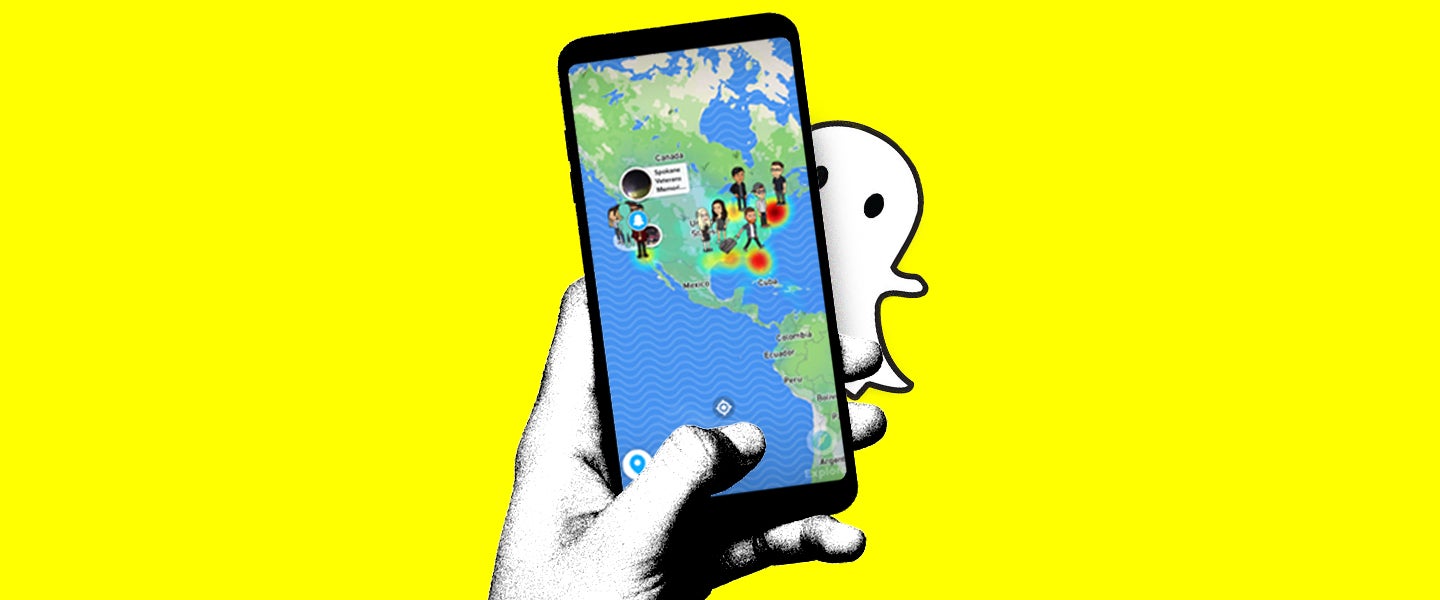“Who still uses Snapchat?” my brother’s 24-year-old girlfriend asked the other day. Well, I do, Rosie. And so do the teens. Despite what you’ve heard about Snapchat dying off, it’s still very much a thing for my generation.
Though Business Insider reported in April that the app is projected to lose 2.8 percent of its users this year, it’s still averaging 77.5 million monthly users. As my 17-year-old cousin Caiti bluntly said when I texted her about it, “Snapchat is still very popular.”
One thing that has changed, however, is the Snap Map. That’s Snapchat’s tool that allows users to track their contacts’ locations. Snapchat debuted the feature in June 2017, and it quickly became popular — and controversial — among high schoolers, who could monitor where their friends were at any moment.
Although I’m five years out of high school and didn’t have the Snap Map feature until college, I gained most of my Snapchat friends as a teen. So every morning, I still check the app and look at my Snap Map. Some deep part of my soul needs to know where my World History class partner is at all times. (For those wondering, he’s thriving in Pittsburgh.)
I hoped I wasn’t the only one still Snap Mapping, so I talked to other Gen Z-ers about how they use the feature.
One such Snap Mapper is my former prom date, Abigail, who just moved back home to Chicago after living in Boston. She uses Snap Map for updates on where her night might lead her, and what parties her crush is attending.
The biggest consensus, however, is that Snap Map is great for ghosting.
Anna, a childhood friend who lives in Milwaukee, called the map “an excellent tool for avoiding people.” She is just one of the many young people who use Snap Map not to connect with their friends, but to ignore them.
snap maps is so useful if you live in a small town cuz u can avoid the areas that u see ppl u know are at ☺️
— toby L-E (@Iavendeer) May 18, 2019
“I’m not the most outgoing or chatty person, so small-talking with people who I haven’t seen for several years isn’t my idea of fun,” says Toby Lewis, an 18-year-old from Salisbury, England.
Lewis has lived his entire life in Salisbury and estimates he might know up to 90 percent of teens in town. Most hang out at Wetherspoons, a quick and cheap chain pub. Some days, Toby would rather avoid small talk then score a sweet lunch deal: “Looking on Snapchat makes me aware of where certain people or groups are, and I can avoid them where possible.”
You might think he’s being paranoid. But monitoring Snap Maps is actually a vital way for him and others to manage their anxiety.
said it before and I’ll say it again: the best use of snap maps is seeing where your enemies are as to better avoid them
— hf (@hol7ly) May 28, 2019
Whenever Holly Fleming is overstressed or anxious, she has a tendency to pluck out the hair on her arms. (It’s a condition called trichotillomania, though Fleming hasn’t been officially diagnosed.) To help her manage her stress, she’ll check Snap Map before heading out the door every day.
She likes to zoom in on the Subway sandwich shop near her work. An old friend works there — someone Fleming isn’t as close with today. “I use the Snap Map to see if he’s on shift before I go there to get my lunch,” Fleming says. “Sometimes I’m just not in the mood for awkward small talk when I’m stressed at work.”
I think the point of the snap map is to make plans with people nearby but imma use it to avoid people
— Toby✨ (@tobydisneychap) June 22, 2017
For other teens, Snap Map is a very real safety buffer to steer clear of people they aren’t on good terms with. “My ex-boyfriend lives near me, so I don’t go to places he’s at,” says Toby Chapman, an 18-year-old from Kent County, England. Snap Map can pinpoint the exact store or even house where a user is located. So when Chapman sees his ex is at the mall, he doesn’t go, because “he always tries to start arguments.”
Occasionally, the app can have the opposite effect of helping people avoid dangerous encounters. Both parents and police departments immediately criticized Snap Map upon its debut for publicizing user locations. It doesn’t help that Snapchat as a whole has problems with abuse.
I wish more people would turn on snap map so I could avoid running into them
— Annabelle Schwartz (@annabmaes) May 25, 2019
Annabelle Schwartz, a 20-year-old from New York City, used to love following her friends throughout the day on Snap Map. But then a man she matched with on Tinder and added on Snapchat showed up unannounced to the Trader Joe’s where she works and followed her around the store. “I’ve always known that people could use it as a tool to be creepy,” Schwartz says. “I just didn’t realize I would have those people in my circle.”
Schwartz no longer shows her location on Snap Map. She put herself in Ghost Mode, which allows users to hide their location. However, anyone can still find their friends on Snap Map who haven’t turned off tracking settings. Many people who use Snap Map to avoid others tell me they’ve made themselves undetectable. “I don’t think anyone needs to track me,” Lewis says. “They have made the decision to be seen on Maps.”
Now that Schwartz is entering her 20s and her high school friends are spread across the country, she’s started using Snapchat much less. She’s finding her using Instagram’s Close Friends feature and Apple’s Find My Friends app more often. However, like me, she still inevitably checks back in on Snapchat regularly, especially when home in Portland: “It’s mostly about not running into people from high school if I’m going to a party or event.”
However, she also notes, “if I really hate them, I’ve deleted them from Snap anyway.”

